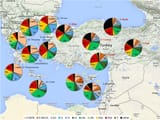>>515074703
>In an Afshar village near Ankara where, according to oral tradition, the ancestors of the inhabitants came from Central Asia, the researchers found that 57% of the villagers had haplogroup L, 13% had haplogroup Q and 3% had haplogroup N. The high rate of haplogroup L observed in this study, which is most common in South Asia, was difficult for researchers to explain and could not be traced back to any specific geographic location, and authors said it would be difficult to associate this haplogroup with the Turkic migrations, given the paucity of evidence. Furthermore, 10% of the Afshars had haplogroups E3a and E3b, while only 13% had haplogroup J2a, the most common in Turkey
>By contrast, the inhabitants of a traditional Turkish village that had little migration had about 25% haplogroup N and 25% J2a, with 3% G and close to 30% R1 variants (mostly R1b)
>Y-DNA comparison of Turkish and Greek-speaking populations of Cyprus, Anatolia, Thrace, the Aegean, and peninsular Greece (Citation: Heraclides et al. 2017 Y-chromosomal analysis of Greek Cypriots reveals a primarily common pre-Ottoman paternal ancestry with Turkish Cypriots. PLoS ONE 12(6): e0179474. doi:10.1371/journal.pone.0179474
